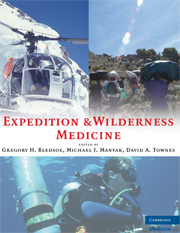Book contents
- Frontmatter
- Contents
- Contributors
- Foreword
- Preface
- Acknowledgments
- PART I EXPEDITION PLANNING
- PART II EXPEDITIONS IN UNIQUE ENVIRONMENTS
- PART III ILLNESS AND INJURIES ON EXPEDITIONS
- 24 General Medical
- 25 The Diarrhea of Travelers
- 26 Malaria: Diagnosis, Prevention, and Treatment for the Traveler
- 27 Wild Animal Attacks and Injuries
- 28 Snake and Arthropod Envenoming
- 29 Hazardous Marine Life
- 30 Expedition Toxicology
- 31 Environmental Injuries
- 32 Penetrating and Explosive Wounds
- 33 Drowning and Submersion Injury
- 34 Evaluation and Acute Resuscitation of the Trauma Patient
- 35 Principles and Practice of Expedition Wound Management
- 36 Expedition Eye Injuries and Disorders
- 37 Dental Medicine on Expedition
- 38 Foot Injuries
- 39 Expedition Orthopedics
- 40 Expedition Self-Rescue and Evacuation
- 41 Aeromedical Evacuations
- APPENDIX The Expedition Medical Kit
- Index
32 - Penetrating and Explosive Wounds
from PART III - ILLNESS AND INJURIES ON EXPEDITIONS
Published online by Cambridge University Press: 05 March 2013
- Frontmatter
- Contents
- Contributors
- Foreword
- Preface
- Acknowledgments
- PART I EXPEDITION PLANNING
- PART II EXPEDITIONS IN UNIQUE ENVIRONMENTS
- PART III ILLNESS AND INJURIES ON EXPEDITIONS
- 24 General Medical
- 25 The Diarrhea of Travelers
- 26 Malaria: Diagnosis, Prevention, and Treatment for the Traveler
- 27 Wild Animal Attacks and Injuries
- 28 Snake and Arthropod Envenoming
- 29 Hazardous Marine Life
- 30 Expedition Toxicology
- 31 Environmental Injuries
- 32 Penetrating and Explosive Wounds
- 33 Drowning and Submersion Injury
- 34 Evaluation and Acute Resuscitation of the Trauma Patient
- 35 Principles and Practice of Expedition Wound Management
- 36 Expedition Eye Injuries and Disorders
- 37 Dental Medicine on Expedition
- 38 Foot Injuries
- 39 Expedition Orthopedics
- 40 Expedition Self-Rescue and Evacuation
- 41 Aeromedical Evacuations
- APPENDIX The Expedition Medical Kit
- Index
Summary
INTRODUCTION
In the twenty-first century, it is an unfortunate fact that individuals on an expedition could become victims of penetrating and/or explosive trauma, whether as a result of being accidentally shot from hunting occurring nearby, becoming inadvertently shot while being caught up in political turmoil, or being involved in an explosive event that is not uncommon in many parts of the world. The medical provider treating penetrating and explosive trauma in the austere environment is faced with multiple challenges including a lack of medical supplies, prolonged evacuation time, and distance and lack of sophisticated care that is the standard for trauma care in the urban environment. This chapter will cover the evaluation and treatment of penetrating and explosive injuries in the austere environment.
PHYSICS AND EPIDEMIOLOGY
Ballistics
The energy available for a missile to inflict upon the body is dependent on the equation E = ½MV2, where M is the mass of the bullet (larger bullets impart more energy) and V is the velocity of the bullet as it hits the tissue. Thus, in most cases, the potential damage is greatest with a high velocity round such as that seen with modern assault rifles and high-velocity hunting weapons.
For missile injuries, there are two areas of projectile–tissue interaction.
The first is a permanent cavity, which is a localized area of necrotic tissue and clot, proportional to the size of the projectile as it passes through.
- Type
- Chapter
- Information
- Expedition and Wilderness Medicine , pp. 492 - 514Publisher: Cambridge University PressPrint publication year: 2008



